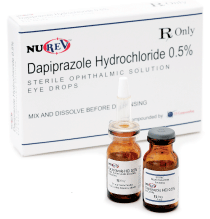 One advantage of getting older is that, if you hang onto your possessions long enough, they often seem to come back into fashion. Paisley ties from the late 1980s, long buried in a box in the attic, are suddenly all the rage again. And, your teenage daughter absolutely has to have those old, beat up jeans from your college days because they are, like, totally awesome.
One advantage of getting older is that, if you hang onto your possessions long enough, they often seem to come back into fashion. Paisley ties from the late 1980s, long buried in a box in the attic, are suddenly all the rage again. And, your teenage daughter absolutely has to have those old, beat up jeans from your college days because they are, like, totally awesome.
Optometry has certainly seen its share of therapeutic fads during the last 100 or so years. A few of these, like oversized frames and Propine drops, have mercifully drifted into oblivion; others have held steadfast, or in some cases, recurred periodically. One therapy thats returning to the mainstream now is dapiprazole.
Historical Perspective
In 1991, a new product promised to revolutionize the practice of eye care. At the time, optometry had just completed a 20-year battle to gain the use of diagnostic drugs in all 50 states, beginning with
Despite the victory, however, there was still substantial resistance within optometry to deviate from the status quo. Arguments against routine pharmacologic dilation typically centered on the perceived inconvenience to the patient in terms of additional time, discomfort and induced visual distortion associated with both mydriasis and impaired accommodation.
So, many practitioners continued to perform dilated funduscopy only on an as needed basis. Legal precedents, however, soon helped to establish pupillary dilation as the standard of care in the United States.2,3 And, as the tide began to turn, practitioners sought new modalities that could potentially improve the experience for their patients as well as themselves.
The Hope
Dapiprazole, marketed under the trade name Rev-Eyes (manufactured by Abbott Laboratories and marketed by Storz Ophthalmics), was the perceived answer to optometrists prayers. This pharmacologic agent received FDA approval on December 31, 1990, and offered an antidote to pupillary dilation. Technically, dapiprazole 0.5% carried an indication for the treatment of iatrogenically induced mydriasis produced by adrenergic (phenylephrine) or parasympatholytic (tropicamide) agents.4
Dapiprazole is classified as an alpha-adrenergic blocking agent; it counters mydriatic drugs and stimulates pupillary constriction. In addition to counteracting dilation, dapiprazole shows a beneficial effect toward restoration of impaired accommodation.5
Initial studies involving this drug were very promising. Effects were seen as rapidly as 10 minutes following instillation.6,7 Additionally, the drug was found to be extremely safe, showing virtually no effect on intraocular pressure, blood pressure or heart rate.8 And, unlike direct-acting parasympathomimetic agents, such as pilocarpine, there was no reduction in anterior chamber depth associated with dapiprazole, thereby eliminating the associated risk of pupillary block, angle closure glaucoma and retinal detachment.7,8
After its release, many practitioners tried dapiprazole in their offices. It was speculated that this drug might dramatically impact the profession. For example, Drs. Jimmy Bartlett and John Class wrote the following in a 1992 publication: The arrival of mydriatic antagonists is an important event. It seems reasonable to believe that the time-honored rationales for not employing routine pupillary dilation will begin to pale in relation to the advantages offered by these new drugs. The perceived disadvantages of routine dilation (e.g., potential angle closure, patient inconvenience) should be significantly offset by the use of mydriatic antagonists.8
The Reality
Despite favorable clinical studies, the drug tended to work somewhat slowly in practice, taking as long as two hours in some cases to return pupils to pre-dilation status.7 More to the point, patients often found the side effects of dapiprazole to be quite unpleasant. Stinging upon instillation occurred in nearly half of patients, whereas conjunctival hyperemia was encountered in more than 80%.4 Some practitioners dubbed dapiprazole Red-Eyes.
The other major issue with dapiprazole was costroughly four or five times more than typical diagnostic drugs, and once opened, each bottle had a shelf life of only 21 days.4 Moreover, the recommended dosing of this product was four drops per eyetwo drops, followed five minutes later by an additional two drops.
Because of the additional expense and minimal return on investment, many practitioners had difficulty justifying the use of dapiprazole in their day-to-day practice. In some cases, doctors who normally included dilation of the pupils in the cost of the examination hit upon the questionable solution of charging an additional fee for dilation reversal on a fee-for-service basis.
 A Modern Concept
A Modern Concept
While routine pupillary dilation is most certainly now the standard of care within optometry, the same arguments and issues that were present 20 years ago persist todaydilation is still disliked by most patients, and it presents practical challenges for physicians as well. Rev-Eyes is no longer available in the
Like Rev-Eyes, NuRev is supplied as a package containing one sterile vial of dapiprazole hydrochloride lyophilized powder (25mg), one vial of diluent (5mL) and a dropper for dispensing the reconstituted solution. Retail cost of the product is approximately $42. While the four-drops-per-eye regimen is still recommended, studies have shown that using just two drops over five to 10 minutes may be clinically equivalent.9 Some also suggest that instilling one drop in each eye prior to a dilated fundus evaluation and another drop upon completion of ophthalmoscopy is adequate to obtain the desired pharmaceutical effect without disrupting exam flow.10
Though dapiprazole may not be the universal remedy for our dilation conundrum, it has proven to be beneficial in other clinical scenarios. For example, numerous studies have demonstrated this drug is a remedy for night haloes secondary to LASIK.11-13 By stimulating miosis without affecting accommodation, dapiprazole can help eliminate postoperative blur and aberrations that sometimes plague refractive surgery patients.10-12
Likewise, the miotic effect of dapiprazole may be desirable in pseudophakic patients with large pupils who experience similar phenomena.14 Finally, a small body of evidence suggests that dapiprazole may be able to reduce intraocular pressure in patients with pigmentary glaucoma. The mechanism of action is believed to be due to iridoplegia, which leads to decreased shedding of pigment and increased outflow facility.15
Within the realm of health care, the longevity of certain medications can be as transient as fashion trends or popular music. While some drugs never truly go out of style, many others seem to disappear virtually overnight. Dapiprazole appears to be one of those unique entities that have gained a second chancebut will it succeed this time around?
Drs. Kabat and Sowka have no financial interest in any of the products mentioned in this article.
1. Cooper SL. The licensure mobility experience within the
2. Class JG. A review of 50 malpractice claims. J Am Optom Assoc 1989 Sep;60(9):694-706.
3. Class JG. The eye-opening case of Keir v
4. Focus Laboratories, Inc. NuRev package insert. 2008.
5. Nyman N, Reich L. The effect of dapiprazole on accommodative amplitude in eyes dilated with 0-5 percent tropicamide. J Am Optom Assoc 1993 Sep;64(9):625-8.
6. Bucci MG, DAndrea D, Bettini A, DeGregorio M. Dapiprazole for reversal of mydriasis due to tropicamide. Glaucoma 1987; 9:94-8.
7. Allinson RW, Gerber DA, Bieber S, Hodes BL. Reversal of mydriasis by dapiprazole. Ann Ophthalmol 1990 Apr;22(4):131-3,8.
8.
9. Wilcox CS, Heiser JF, Crowder AM, et al. Comparison of the effects on pupil size and accommodation of three regimens of topical dapiprazole. Br J Ophthalmol 1995 Jun;79(6):544-8.
10. Melton R, Thomas R. Clinical Guide to Ophthalmic Drugs. 2008 June 15;146(6 Suppl):56A.
11. Alster Y, Loewenstein A, Baumwald T, et al. Dapiprazole for patients with night haloes after excimer keratectomy. Graefes Arch Clin Exp Ophthalmol 1996 Aug;234 Suppl 1:S139-41.
12. Marx-Gross S, Krummenauer F, Dick HB, Pfeiffer N. Brimonidine versus dapiprazole: Influence on pupil size at various illumination levels. J Cataract Refract Surg 2005 Jul;31(7):1372-6.
13. Canovetti A, Nardi M, Figus M, et al. Aceclidine, brimonidine tartrate, and dapiprazole: comparison of miotic effect and tolerability under different lighting conditions. J Cataract Refract Surg 2009 Jan;35(1):42-6.
14. Leccisotti A. Dapiprazole for night halos caused by angle-supported phakic intraocular lenses. J Refract Surg 2004 Sep-Oct;20(5):489.
15. Mastropasqua L, Carpineto P, Ciancaglini M, et al. Effect of dapiprazole, an alpha-adrenergic blocking agent, on aqueous humor dynamics in pigmentary glaucoma. Ophthalmic Res 1996;28(5):312-8.
16. Mastropasqua L, Carpineto P, Ciancaglini M,
17. Lehto I, Vesti E. Diagnosis and management of pigmentary glaucoma. Curr Opin Ophthalmol 1998 Apr;9(2):61-4.

